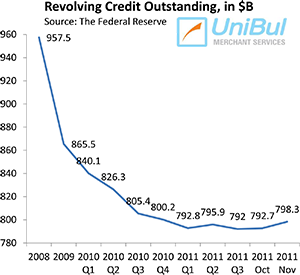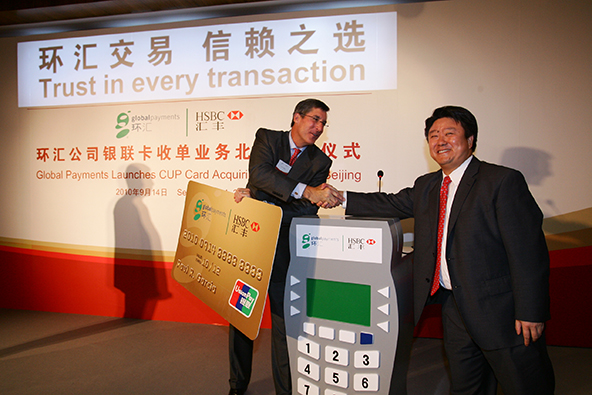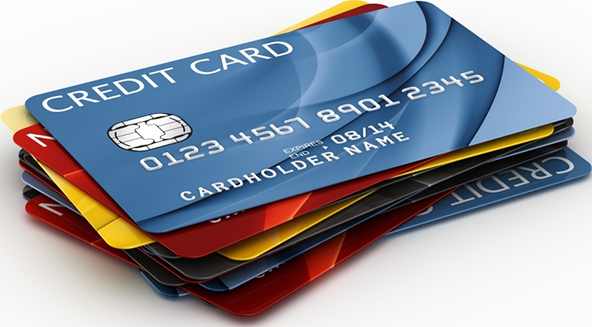Late Payments on Credit Cards Hit an All-Time Low in the U.S.

Just when we thought that the credit card delinquency rate in the U.S. may have bottomed out, it resumed its fall in December, according to the latest data from Moody’s Credit Card Indices. The late payments rate had remained virtually unchanged in the previous four months. Much more expected was the reported fall in the rate measuring the U.S. credit card defaults, as its uptick in November was widely considered to be a one-off aberration from the long-term downward trend.
The six largest U.S. card issuers were evenly split in their charge-off results for December, with Bank of America, Discover and Chase reporting increases, while Citigroup, Capital One and American Express registered decreases in the month. All of them, however, reported lower delinquency rates.
Credit Card Charge-offs Down 0.34%
The fall in credit card defaults in December was widely expected. Moody’s has for a long time predicted that charge-offs will fall below four percent before the end of this year. The present level — 5.04 percent — is 2.99 percent lower than the rate measured by Moody’s at the end of 2010, a decline of 37.24 percent — the sharpest year-on-year drop in history.
The charge-off (or default) rate represents the ratio of accounts with outstanding credit card balances that card issuers no longer expect to be repaid by their cardholders, with respect to the total number of open accounts. Charged-off accounts are consequently written off of the issuers’ accounting books as losses, typically at 180 days after the last payment on the account.
Late Payments Fall to 2.91% — a New All-Time Low
Moody’s credit card delinquency rate had remained virtually flat from September through November of last year, having previously fallen for 22 months in a row. It looked as if it may have reached the bottom, but evidently there was still room to fall. The late payments rate decreased by 0.12 percent and is under three percent for the first time ever.
Moody’s headline delinquency rate represents the ratio of credit card accounts on which payments are late by 30 days or more to the total number of open accounts. The agency’s “early-stage delinquency rate,” which keeps track of payments late by 30 – 59 days, also fell in December — by six basis points to 0.80 percent. This is also a record.
These extremely low and falling delinquency rates are the reason charge-offs are expected to decrease by more than a percentage point from their present level by the end of this year. This is a fairly safe prediction, considering that the charge-off rate is a trailing indicator for the delinquency one.
All Top U.S. Issuers Report Lower Delinquencies
As if making a statement, each of the six biggest U.S. credit card issuers reported a lower delinquency rate in December. They were, however, split on defaults, which is a much more customary occurrence. Here is what each one of them reported:
|
Charge-off Rate, % of Total |
Delinquency Rate, %of Total |
|||
|
November 2011 |
December 2011 |
November 2011 |
December 2011 |
|
|
Bank of America |
5.67 |
6.05 |
3.96 |
3.82 |
|
JPMorgan Chase |
4.02 |
4.11 |
2.54 |
2.48 |
|
Discover |
3.04 |
3.15 |
2.43 |
2.32 |
|
Capital One |
4.29 |
3.98 |
3.73 |
3.66 |
|
American Express |
2.40 |
2.30 |
1.50 |
1.40 |
|
Citigroup |
5.36 |
5.11 |
3.28 |
3.11 |
Here is how the issuers’ December 2011 figures compare to the post-Lehman record-highs in each category:
|
Charge-off Rate, % of Total |
Delinquency Rate, % of Total |
|||
|
Record, %/Month |
Change, % |
Record, %/Month |
Change, % |
|
|
Bank of America |
14.53/Aug 2009 |
58.36 |
8.01/Aug 2009 |
52.31 |
|
JPMorgan Chase |
10.91/Jan 2010 |
62.33 |
4.95/Sep 2009 |
49.90 |
|
Discover |
9.11/Feb 2010 |
65.42 |
5.72/Oct 2009 |
59.44 |
|
Capital One |
10.87/Apr 2010 |
63.39 |
5.80/Jan 2010 |
36.90 |
|
American Express |
10.40/Apr 2009 |
77.88 |
5.30/Feb 2009 |
73.58 |
|
Citigroup |
12.14/Aug 2009 |
57.91 |
6.06/Mar 2010 |
48.68 |
American Express continues to lead the pack in absolute declines, as well as in biggest percentage drops in both categories.
The Takeaway
So the December delinquency numbers caught many of us by surprise. Yet, I just can’t see them falling much further, if at all. As it is, the late payments rate for each of the top issuers is below three percent and for half of them it is under two-and-a half percent. But even if the aggregate delinquency rate rises slightly in the coming months, it will almost certainly bring the charge-off rate down to under four percent sooner than Moody’s expects.
 Another good news, perhaps the most important one to come out of Moody’s report, was that the rate at which Americans were repaying their outstanding credit card balances in December — the monthly payment rate (MPR) — had spiked by more than one percent from the previous month’s level. The MPR was reported at 21.58 percent, up from 20.56 percent in November, and is only 0.33 percent lower than the all-time record of 21.91 percent set in August of last year. Historically, the average has hovered in the mid-teens.
Another good news, perhaps the most important one to come out of Moody’s report, was that the rate at which Americans were repaying their outstanding credit card balances in December — the monthly payment rate (MPR) — had spiked by more than one percent from the previous month’s level. The MPR was reported at 21.58 percent, up from 20.56 percent in November, and is only 0.33 percent lower than the all-time record of 21.91 percent set in August of last year. Historically, the average has hovered in the mid-teens.
What makes all these numbers even more impressive is that the Federal Reserve reported a huge spike in credit card use in November, which was also the third consecutive monthly increase. So even as Americans are beginning to use their credit cards more freely once again, they seem to be doing so within their means. I hope this turns out to be the beginning of a long-term trend.

